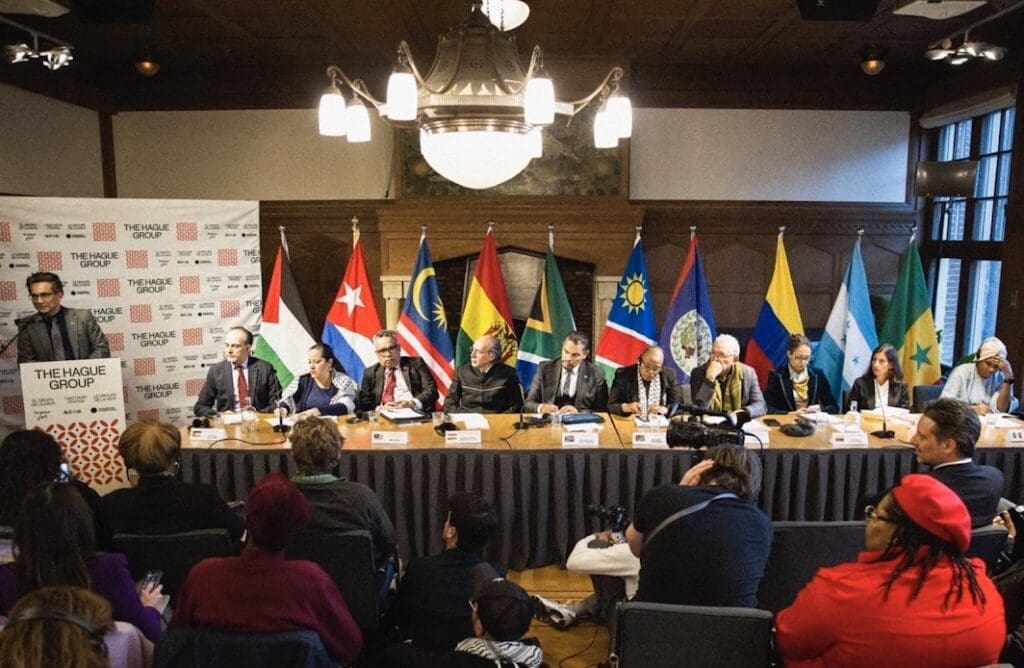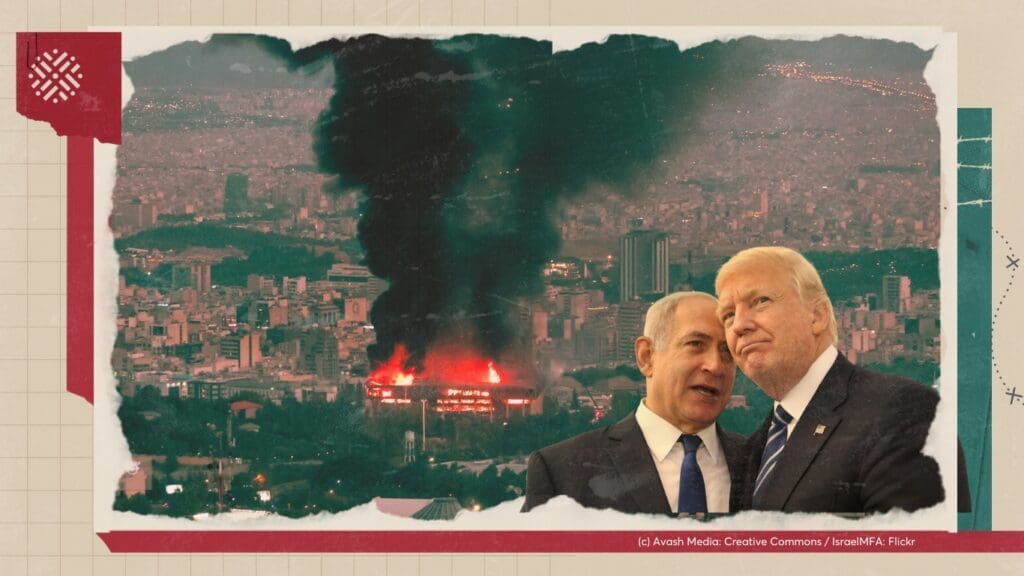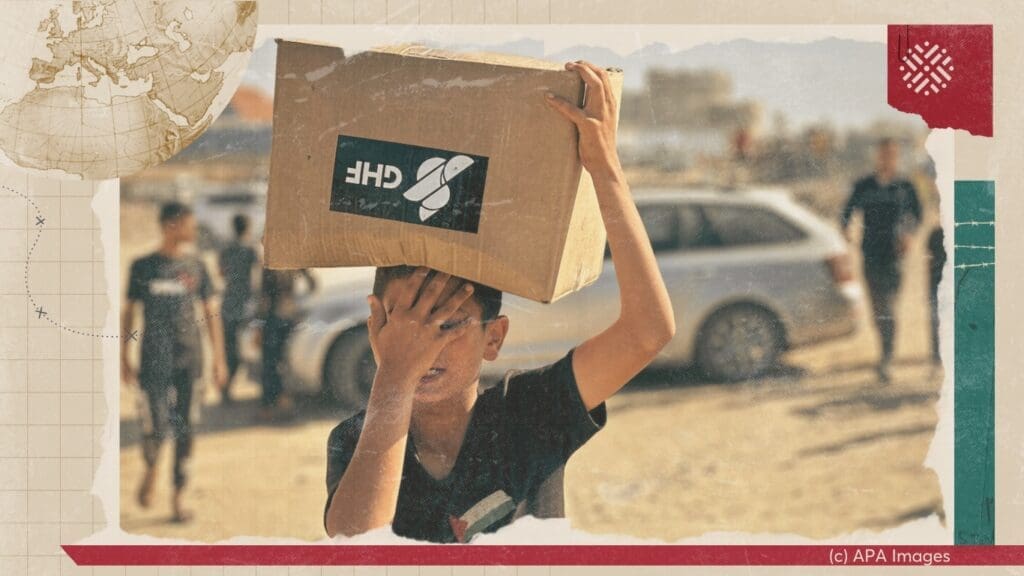- Topics
-
Topics
See our analysis on civil society and how it shapes culture, politics, and policies
Read our insights on the shifting political landscape and what it means for Palestine
Learn more about the policies and practices shaping the Palestinian economy
Strengthen your understanding of the unique conditions for Palestinian refugees across the Middle East
-
- Analysis
-
Analysis
In-depth analysis on existing or potential policies that impact possibilities for Palestinian liberation.
Insights and perspectives on social, political, and economic questions related to Palestine and Palestinians globally.
Concise analysis into a specific policy, its background and implications.
Commentary that brings together insights from multiple analysts.
Compilations of past Al-Shabaka works surrounding a specific theme.
Longer-form, ad hoc projects that seek to confront research questions outside the scope of our regular analysis.
A policy-driven research initiative by Al-Shabaka: The Palestinian Policy Network.
Our monthly webinar series that brings together Palestinian experts.
Featured
The Israeli regime’s ongoing genocide in Gaza has exposed the failure of international legal frameworks to protect civilians, marking an unprecedented breakdown in the protective function of international law. While the Genocide Convention obligates states to prevent and punish genocide, and the Geneva Conventions establish protections for civilians under occupation, these mechanisms have proven powerless without the political will to enforce them. In this context, eight Global South states—South Africa, Malaysia, Namibia, Colombia, Bolivia, Senegal, Honduras, and Cuba—have launched the Hague Group, a coordinated legal and diplomatic initiative aimed at enforcing international law and holding the Israeli regime accountable. This policy memo examines the group’s efforts to challenge entrenched Israeli impunity. It highlights the potential of coordinated state action to hold states accountable for violating international law, despite structural limitations in enforcement. Munir Nuseibah· Jul 8, 2025On Thursday, June 19, 2025, Israeli Prime Minister Benjamin Netanyahu stood in front of the aftermath of an Iranian strike near Bir al-Saba’ and told journalists: “It really reminds me of the British people during the Blitz. We are going through a Blitz.” The Blitz refers to the sustained bombing campaign carried out by Nazi Germany against the UK, particularly London, between September 1940 and May 1941. With this dramatic comparison, Netanyahu sought to elicit Western sympathy and secure unconditional support for his government’s latest act of military escalation and violation of international law: the unprovoked bombing of Iran. This rhetorical move is far from new; it has become an enduring trope in Israeli political discourse—one that casts Israel as the perennial victim and frames its opponents as modern-day Nazis. Netanyahu has long harbored ambitions of striking Iran with direct US support, but timing has always been central. This moment, then, should not be viewed merely as opportunistic aggression, but as part of a broader, calculated strategy. His actions are shaped by a convergence of unprecedented impunity, shifting regional dynamics, and deepening domestic political fragility. This commentary examines the latest escalation in that context and discusses the broader political forces driving it.
Munir Nuseibah· Jul 8, 2025On Thursday, June 19, 2025, Israeli Prime Minister Benjamin Netanyahu stood in front of the aftermath of an Iranian strike near Bir al-Saba’ and told journalists: “It really reminds me of the British people during the Blitz. We are going through a Blitz.” The Blitz refers to the sustained bombing campaign carried out by Nazi Germany against the UK, particularly London, between September 1940 and May 1941. With this dramatic comparison, Netanyahu sought to elicit Western sympathy and secure unconditional support for his government’s latest act of military escalation and violation of international law: the unprovoked bombing of Iran. This rhetorical move is far from new; it has become an enduring trope in Israeli political discourse—one that casts Israel as the perennial victim and frames its opponents as modern-day Nazis. Netanyahu has long harbored ambitions of striking Iran with direct US support, but timing has always been central. This moment, then, should not be viewed merely as opportunistic aggression, but as part of a broader, calculated strategy. His actions are shaped by a convergence of unprecedented impunity, shifting regional dynamics, and deepening domestic political fragility. This commentary examines the latest escalation in that context and discusses the broader political forces driving it. Yara Hawari· Jun 26, 2025Launched on May 26, 2025, and secured by US private contractors, the new Israeli-backed aid distribution system in Gaza has resulted in over 100 Palestinian deaths, as civilians navigated dangerous conditions at hubs positioned near military outposts along the Rafah border. These fatalities raise grave concerns about the safety of the aid model and the role of US contractors operating under Israeli oversight. This policy memo argues that the privatization of aid and security in Gaza violates humanitarian norms by turning aid into a tool of control, ethnic cleansing, and colonization. It threatens Palestinian life by conditioning life-saving aid, facilitating forced displacement, and shielding the Israeli regime from legal and moral responsibility. It additionally erodes local and international institutions, especially UNRWA, which has been working in Gaza for decades.
Yara Hawari· Jun 26, 2025Launched on May 26, 2025, and secured by US private contractors, the new Israeli-backed aid distribution system in Gaza has resulted in over 100 Palestinian deaths, as civilians navigated dangerous conditions at hubs positioned near military outposts along the Rafah border. These fatalities raise grave concerns about the safety of the aid model and the role of US contractors operating under Israeli oversight. This policy memo argues that the privatization of aid and security in Gaza violates humanitarian norms by turning aid into a tool of control, ethnic cleansing, and colonization. It threatens Palestinian life by conditioning life-saving aid, facilitating forced displacement, and shielding the Israeli regime from legal and moral responsibility. It additionally erodes local and international institutions, especially UNRWA, which has been working in Gaza for decades. Safa Joudeh· Jun 10, 2025
Safa Joudeh· Jun 10, 2025
-
- Resources
- Media & Outreach
- The Network




Palestine and COVID-19: Lessons for Leadership During Times of Crisis
Overview
The Palestinian Authority (PA) won praise for its handling of the first wave of COVID-19 that swept over the occupied Palestinian territory (OPT) in the spring of 2020. However, while many of the challenges the PA faced were due to ongoing Israeli assaults on Palestinian lives, lands and rights, others can be traced to decades of domestic mismanagement and misuse of resources together with growing authoritarianism.12
With the second COVID-19 wave in full-throttle, economic crisis at hand, and the looming threat of further Israeli annexation, how will the PA — and Palestinians — cope? Al-Shabaka policy analysts Fadi Quran and Tahani Mustafa analyze the current PA response against the backdrop of the lasting implications of the problematic policies of the past.
A Strong Initial Response
The PA adopted an instantaneous and severe response after the first cases of COVID-19 emerged in Bethlehem on March 5th. Within hours, Prime Minister Mohammad Shtayyeh declared a state of emergency, closing down all public spaces and imposing travel restrictions in and out of Bethlehem. The PA soon rolled out a stricter curfew, this time across the entirety of the West Bank under its authority and enforced a 14-day stay-at-home order.
The PA devised and implemented its response based on a universal set of key measures in the management of an epidemic. Benchmarks were set based on rates of infection and social compliance. Unpopular decisions were well explained via effective and clear risk and community engagement measures. These included, but were not limited to, the dissemination of Arabic materials on hygiene awareness and preventive measures related to COVID-19. The Palestinian Ministry of Health disseminated advice in conjunction with its partners, the WHO and UNICEF, and supported by a private task force comprising the Bank of Palestine and the Palestinian International Cooperation Agency. The advice incorporated a range of information on how to home quarantine and wear masks as well as do’s and don’ts for COVID-19. It also included advice for pregnant women and lactating mothers as well as on gender-based violence. Public service announcements were communicated via billboards, Palestinian TV and radio, and SMS by mobile network providers.
Leadership under crisis requires making decisions with speed and precision, and here the PA initially proved capable Share on XAt the same time the Ministry of Education and UNRWA had operationalized their own campaign, providing guidance for parents and caregivers on student pastoral care during quarantine. Various ad hoc government coordination bodies were set up, most notably the National Emergency Committee consisting of representatives of the Prime Minister’s office, the Ministry of Health, and the various security branches. Even Palestinian localities designated as Areas B saw strict closures and curfews applied.3 Local civic emergency committees were set up throughout the Palestinian territories. As Israel prevents the PA from operating outside Area A, local groups, many of them Fatah activists close to the PA, set up checkpoints and emergency committees in those villages. Support from the PA was provided through technical advice and resources. Although decision-making protocols were set from the top, implementation was at the prerogative of each district governor.4
Palestinians note, often jokingly, that their familiarization with curfews and restrictions on movement after decades of Israeli occupation had prepared them for such a “historic” moment. Indeed, Palestinian society immediately and effectively complied with the shutdown orders, significantly curtailing the initial spread of the virus. According to official government figures, the first wave brought about 1,588 confirmed cases and three deaths compared to over 22,000 cases and over 309 deaths recorded in Israel during the same period.
It is worth noting that the PA Security Forces (PASF) had in March 2019 requested — and received — international assistance for a simulation exercise to manage the potential of public health crisis in the event of an outbreak such as MERS (Middle East Respiratory Syndrome).5 During the workshop, which consisted of representatives from across the various branches of the security sector, potential issues were anticipated and suggestions made for the establishment of inter-agency bodies. Thus, Palestine’s initial response was relatively well-prepared and effective, particularly against the backdrop of a chaotic and disorganized global response to COVID-19. Leadership under crisis requires making decisions with speed and precision, and here the PA initially proved capable. Indeed, the PA response was praised by Palestinians as well as their international patrons.
Past Policies Left No Choice But Shutdown
The fact is that the PA had limited options at its disposal beyond that of an instantaneous and strict lockdown. The health sector was already in a state of collapse and, as the simulation workshop had shown, any hesitation or delay in response could have proven disastrous. Indeed, the state of the health sector is such that, up until March 6th of this year, the Palestinian Doctor’s Association and health workers across Palestine had undertaken strike action to demand more government investment. At a local Press conference the week preceding the COVID-19 outbreak in Palestine, the movement’s spokesperson, Dr. Shawky Sabha, highlighted the severe logistical shortages across the health sector including beds, equipment, and staff: “In 2012 there were 3,300 doctors and in 2019 we had only 2,550 doctors, and no staff has been appointed yet.” The doctors suspended their strike to deal with the COVID outbreak that followed.
The deficiencies of the health sector come as no surprise. As with other Palestinian public and private socio-economic sectors, the Israeli military occupation’s policies have impeded the development of the Palestinian health sector. This is the result of, amongst other things, preventing the acquisition of supplies and equipment as well as imposing severe constraints on the freedom of movement that is essential for keeping up to date with medical training and development. Israeli policies have also led to a brain drain where, due to lack of opportunities and poor pay, many Palestinian doctors were forced to work abroad. At the local level, there has been a significant lack of PA investment in building up Palestinian health institutions. The security sector — which has built up a record of human rights violations and exacerbated endemic corruption — absorbs more of the PA’s budget than the education, health, and agriculture sectors combined.
When the crisis began, Palestine only had 375 adult intensive care units, and 295 ventilators to serve a population nearly five million. This explains why, despite the significantly low number of cases, the WHO has categorized the OPT as one of the most high risk areas susceptible to COVID 19. Given this context, the PA was forced to deal with the epidemic by using strict containment measures. As the Palestinian Doctor’s Association strike demonstrated, the PA has not budgeted for or prioritised the population’s health. Anything short of shutting down society would have laid bare its failures while putting hundreds of lives at risk.
While our analysis is in no way intended to detract from the impact of Israeli occupation policies, it is also worth considering the ways in which decisions undertaken by the PA have only worsened local conditions for Palestinians, in effect making extreme volatility and uncertainty part of the routine of daily life for residents across the OPT. In many instances the interests of the PA and the Israeli occupation have found synergy, often at the expense of Palestinian citizens, even though the PA is capable of pursuing alternative and more robust policies.
Rather than adapting boldly to the new changes, which would have been a sign of leadership during crisis, the PA’s efforts have instead focused on returning to the status quo. As a result, with the second wave sweeping in, the PA’s inability to develop a more multi-faceted response, beyond quick shut downs has highlighted the lack of resources available to it. Consequently, it is now becoming increasingly exposed as ineffective, overly reliant on the securitization of daily life, and excessively dependent on international aid, counting on the public to shoulder the burdens it faces.
The real credit for leadership should go to Palestine’s varied and scattered local communities Share on XToday, there appears to be nothing preventing both political and security officials from capitalizing on crisis-induced uncertainty. For example, accusations have been levelled at the PA from across the West Bank and Gaza claiming that its officials have selectively distributed donations from the private sector, giving priority to those closely connected to senior PA figures. Similarly, while thousands of Palestinian students were left stranded across the world unable to return home, the reported return of individuals connected to the PA has infuriated the families of those still stranded abroad without any effective assistance to return. It was only after a concerted campaign led by those Palestinians stranded abroad, called Rajouna ala Boyoutna (bring us back to our homes), that the Jordanian government intervened, with the Palestinian Ministry of Foreign Affairs quickly following up and taking action.
When it came to other important segments of the Palestinian population, namely its political prisoners and refugees, the PA proved equally ineffective. The prisoners include an estimated 350 children in Israeli jails, many of whom are being held under harsh conditions. Meanwhile, neither the PA nor the Palestine Liberation Organization (PLO), the representative of the entire Palestinian people, have been able to offer support to those residing in the refugee camps in the neighboring Arab states.
Counting on Community Leadership
With the second wave and an ever increasing resurgence of cases, especially in Hebron, the PA realizes it is incapable of containing the virus indefinitely. Meanwhile Palestinian society – initially supportive and responsive to Prime Minister Shtayyeh’s quick response – has begun to lose faith, in part due to the PA’s failure to reliably deliver on many of the promises it made at the start of the outbreak. The economic situation is worsening, with the World Bank reporting in June: “The reduction in per capita income and the rise in unemployment and poverty will be substantial.” The timing could not have been worse: Palestine already faced a massive fiscal crisis and high unemployment rates reaching 26% in the 12 months that preceded outbreak.
In times of crisis, the test of leadership is defined by how one takes care of the people and communities. Building trust and cohesiveness in the face of political trauma allows for “anti-fragility,” the ability to bounce back stronger.
On this front, the real credit for leadership should go to Palestine’s varied and scattered local communities. Decades of occupation have inadvertently created a resilient population which, despite the depletion of its resources as a result of the Israeli occupation, still has communal reserves to tap into. In fact, reports and research show that the most successful cases of containment and suppression globally required a locally integrated approach, and that what is “central to this approach must be the communities who are at risk and those affected by epidemics.”6 Palestine is no exception: Its reliance on community based structures of support is proving to be its saving grace in the face of COVID-19.
Although little has been said about this topic, the PA’s policies during this pandemic shifted a considerable portion of the economic hardship and responsibility to Palestinian citizens who have, in spite of the circumstances, risen to the occasion. Locally devised social support networks were set up within days, many by Fatah activists close to the authorities. While the efforts remained limited and local, they became essential in the provision of resources for tens of thousands of families affected and in need. Situated within local neighborhoods, towns and villages, these networks of solidarity pooled together, sharing local resources and expertise. Many families were also assisted by remittances from abroad.7
COVID-19 has sharpened the need for more efficient and responsive leadership that is capable of transforming crises into an opportunity…to advance longstanding Palestinian objectives of liberation and justice Share on XIn addition the private sector set up a fund known as Wakfet Ezz (a Stand for Dignity) that collected over $17 million by mid-may and began to make allocations in the West Bank and Gaza in June, although the government was later criticized for prioritizing certain individuals over others, and the money raised by the private sector was seen as insufficient in comparison to the profits made by the relevant donors.
Overall, community-based organizations and individuals were inadvertently given a role during the pandemic which helped to reinforce adherence to rules, at least during the first wave of the virus’ spread. This willingness for societal compliance during times of crisis can be starkly contrasted to the way in which similar policies in states that relied upon politicized and centralized modes of implementation, but lacked trust-based civic input. These include countries such as the United Kingdom, the United States, Brazil and even Palestine’s neighbor Jordan, where efforts to secure compliance were met with overwhelming opposition which played a role in increasing cases of infection as well in increasing government coercion.8
A Moment that Tests All Palestinians
While Palestinians may have avoided the worst of the pandemic’s first wave, this crisis is far from over. In the face of looming annexation and a permanent state of violent Israeli apartheid, COVID-19 has sharpened the need for more efficient and responsive leadership that is capable of transforming crises into an opportunity for public mobilization and deep-rooted change to advance longstanding Palestinian objectives of liberation and justice.
The PA’s current leadership has failed to walk that path, instead keeping its eye on maintaining a stagnant status quo whatever the cost. Rather than seeking a socially collaborative and empowering approach to dealing with the current political and health crisis, it moved quickly toward a securitized approach, with the installation of temporary check-points and heavy security presence across Palestinian streets. This, together with the PA’s preferential treatment of selected members of the political elite, has had a major detrimental effect, notably, the collapse in public trust. The lack of public adherence to the key safety procedures during the second wave has fed the virus. Yet, instead of productively engaging with public criticism and complaints about the economic hardships the people face, the PA has instead pursued a policy of coercion, arresting those that have dared to publicly air their criticism either online or in the streets.
Moreover, the lack of a clear vision and strategy has also led to significant miscommunication within the PA itself. This is best exemplified through one particularly humiliating episode when the PA announced a set of closures only to see, within a few hours, local governors retract the announcement of these measures in their own districts.
But this moment is not only a test for the PA’s top political brass: It is a test for all Palestinians.
Can the people utilize this crisis to strengthen and build new networks of resilience, transform the shape of the economy, and rebuild trust where it has faltered? And can it do so in ways that not only help to weather the storm caused by this virus, but also prepare the ground for resisting Israel’s plans for annexation, dispossession and violation of the most fundamental Palestinian rights, and ultimately re-ignite the struggle for freedom? Palestinian history shows that despite the obstacles, Palestinians have always been resourceful in capitalizing on the opportunities available to them, however limited, and in the current crisis lies the opportunity to do just that.
Tahani Mustafa
Fadi Quran
Latest Analysis
The Hague Group: Mobilizing International Law for Palestine
Timed for Impunity: Israel’s War on Iran
Outsourcing Occupation: US Private Contractors in Gaza
We’re building a network for liberation.
As the only global Palestinian think tank, we’re working hard to respond to rapid developments affecting Palestinians, while remaining committed to shedding light on issues that may otherwise be overlooked.